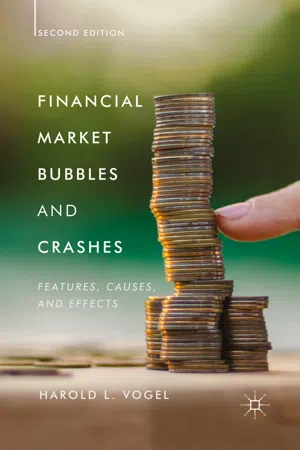1.1 Overview
“Every age has its peculiar folly; some scheme, project, or fantasy into which it plunges, spurred on either by the love of gain, the necessity of excitement, or the mere force of imitation,” wrote Mackay (1841, p. 354), who early on recognized the main features in humanity’s long history of financial speculation.1
Circumstantial and anecdotal evidence of speculation can be traced as far back as ancient Rome and Greece and Babylon (Mesopotamia) . A Mesopotamian crash of sorts was experienced in 1788 BCE when all debts were eliminated by royal decree. Also, lengthy records of barley prices (as related to a consistent measure of silver) showed large-scale annual fluctuations.2
It is important to recognize, however, that as the term is today loosely understood, a “bubble” cannot occur without speculation, but there can be speculation without a “bubble.”3 The presence of mere speculation alone, which was clearly an aspect of trade in the ancient world, is not sufficient to make an asset price “bubble.”
Bubbles are instead characterized by a frenzy of speculation that, fueled by a ready availability of money and credit, collectively invites, stimulates, and enables broad and extreme participation by the public at large. The major bubbles of the last 400 years—Dutch tulip bulbs in the 1600s and the South Sea and Mississippi Bubbles in the 1700s, the 1929 US stock market, Japanese real estate and equities in the 1980s, the Internet stock boom of the 1990s, and real estate circa 2005—all had these features in common.
In classical Athens of the years 479–323 BCE, for instance, the earliest banks, known as trapeza because of the trapezoidal shapes of their dealing tables, were active retail financiers and suppliers of consumer credit and other banking services. According to Cohen (1992, p. 15), trapeza were involved with the perfume business, a major Athens obsession heavily dependent on the availability of credit. Elementary functions including recordkeeping and credit extension—and thus in all likelihood speculative trading—were evidently already known in those times.4
In the days of the Roman Empire,
a period roughly covering the years 27 BCE to 476 CE, a review by Garnsey
and Saller
(
1987, p. 47) notes that “individual aristocrats (and emperors) were proprietors of large warehouses, brickyards and pottery works, or the source of loan capital invested by third parties in, among other things, shipping.” Real estate and moneylending were also important, as were taxes collected by the Roman authorities. Here too, as
Rostovtzeff (
1941) makes clear, speculation on price movements and asset valuation undoubtedly occurred:
The evil effects of the existence of various types of coins were lessened by the establishment of definite rates of exchange. Gold and silver coinage, on the other hand, was monopolized by the state. Though the amount of currency was not sufficient even in these metals, the evils were lessened by the activities of the banks. As agents or concessionaires of the cities, the banks also took an active part in the issue and distribution of local currency, which often led to speculation and profiteering and provoked acute crises. (p. 171)
The depreciation of money was closely connected with the rise in the prices of products of prime necessity…It is not surprising that under such conditions speculation of the wildest kind was one of the marked features of economic life, especially speculation connected with exchange. (pp. 419–20)
Roman bankers, called argentarii, were private businessmen, and as the famed historian Durant (1944, p. 331) recounts, “[T]hey served as money-changers, accepted checking accounts and interest bearing deposits…managed, bought and sold realty (land and buildings), placed investments and collected debts, and lent money to individuals and partnerships.” Within this environment, episodes of money scarcity and credit contractions—that is, deflationary crashes—are also known to have occurred. The Panic of 33 AD, for example, involved the first known instance of intervention by a lender of last resort.5
As for early bubbles, according to Swarup (2014, pp. 83–6), Romans in midfirst-century AD, developed a craze for dining on quite ordinary little fish (red mullets), with competitive bidding sending “prices soaring to stratospheric levels…Tiberius complained bitterly that three mullets had been sold for 30,000 sestertii – enough to pay the annual wages for thirty-three soldiers.”
Bubble-like economic activity, as noted by Hughes (
2011, p. 134), was also seen in the later days of the Roman Empire:
Another outlet for Roman wealth and decadence during this time was art…[the] prices of fashionable ‘fine’ art were fundamentally inflated. Corinthian bronzes were so prized for their workmanship that they cost whole family fortunes. Pliny reported that one ivory table changed hands at 1.3 million sesterces – the price of a large estate…The finest Chinese silk traded…a pound of silk for a pound of gold.
For both Greece and Rome, an inherent and inevitable component of the speculations that occurred was a subtext of familiarity with, and a penchant for, gambling; the nexus between gambling and speculation is strong. Games using astragali—small stones (or bones and early versions of dice)—were played by Greek children and adults, and other wagers on the outcomes of events were also common. All of these elements were expanded upon by the Romans. As Schwartz (2006, p. 25) writes, “[f]atalistic Romans gambled incessantly. Gambling was more than a pastime for the Romans—it was a metaphor for life itself.”
If so, then the presence of such environmental features raises the question: How could there not have been any bubbles?
Although experts on the history of these eras have not been able to specifically identify bubbles per se, that may be because monetary systems were not yet sufficiently developed and/or because price records of transactions never existed, were not comprehensive, or were never found.6 However, given that banking-type money-creating merchants and goldsmiths are known to also have operated in Babylon, Egypt, tenth-century China (the Song Dynasty from 960 to 1279), and the Mongol Empire of Genghis Khan (1206–1368), it would seem likely that speculation and perhaps “bubble-like” condition...
